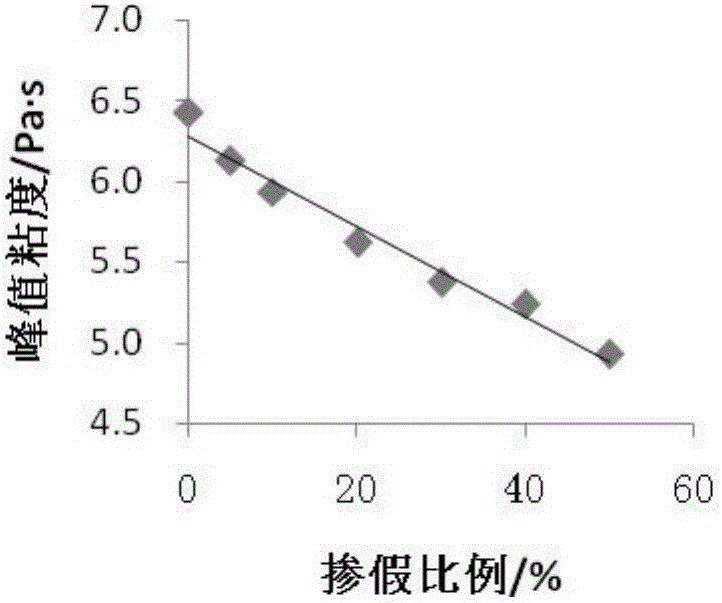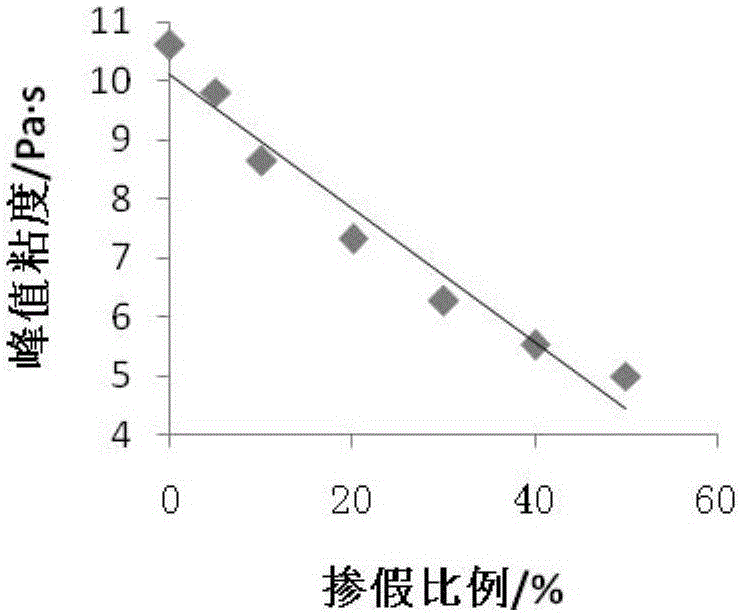Method for rapidly, qualitatively and quantitatively detecting five types of edible starch adulteration
A technology for quantitative detection of edible starch, which is applied in the direction of material analysis by measuring secondary emissions, can solve the problems of time-consuming, complicated operation steps, and inaccurate judgment of adulteration ratio, and achieve the effect of accurate identification of adulteration and simple operation
- Summary
- Abstract
- Description
- Claims
- Application Information
AI Technical Summary
Problems solved by technology
Method used
Image
Examples
Embodiment 1
[0019] Embodiment 1: Qualitative analysis to different adulteration ratio starch
[0020] 1. Scanning and determination of ultra-microscopic morphology of starch granules: Take a small amount of kudzu starch, lotus root starch, lotus seed starch, gorgon starch, canna starch samples and corn starch, and sprinkle them evenly on the metal stage with conductive glue , and then blow out the starch granules scattered around with the ear washing ball, and use the conventional vacuum spraying method to spray gold under vacuum conditions, so that the surface is coated with a conductive film, placed under a scanning electron microscope, and adjusted to the magnification Scanning and photographing pueraria starch, lotus root starch, lotus seed starch, gorgon starch, canna starch and corn starch granules at 3000 times or 1000 times respectively to obtain scanning electron micrographs of the ultra-microscopic morphology of each starch granule, see figure 1 .
[0021] 2. Qualitative analys...
Embodiment 2
[0023] Example 2: Detection of the peak viscosity of starch with different adulteration ratios
[0024] Add corn starch of different qualities to lotus seed starch, gorgon starch, lotus root starch, kudzu root starch and canna starch, and mix evenly with a mixer to obtain adulteration amounts of 0, 5%, 10%, 20%, and 30% respectively , 40%, 50% of the 7 samples, using a rapid viscosity analyzer to determine the gelatinization characteristics of starch with different adulteration ratios, the main gelatinization parameters include peak viscosity, valley value, falling value, final viscosity, return value, The peak time and gelatinization temperature, among which, the peak viscosity values of the five edible starches with different adulteration ratios are shown in Table 1.
[0025] Table 1 - Peak viscosity of five edible starches with different adulteration ratios
[0026]
[0027] According to Table 1, the five starches of kudzu starch, lotus seed starch, lotus root starch,...
Embodiment 3
[0035] Embodiment 3: to the verification test of mixing different proportions of cornstarch
[0036] The established regression equations were verified by pueraria starch, lotus seed starch, lotus root starch, gorgon starch and plantain taro starch with adulteration ratios of 15%, 25%, 35%, and 45%. The verification results are shown in Table 2.
[0037] Table 2-Verification results of five kinds of edible powder mixed with different proportions of corn starch
[0038]
[0039]It can be seen from Table 2 that verification tests were carried out on kudzu starch, lotus seed starch, lotus root starch, Gorgon starch and canna starch when the adulteration amount was 15%, 25%, 35% and 45%, respectively, and the fast viscosity analyzer was used to analyze the The peak viscosities of the five mixed powders can be determined according to the regression analysis equation between the peak viscosities of the five adulterated starches and the adulterated amount, and the predicted adulte...
PUM
 Login to View More
Login to View More Abstract
Description
Claims
Application Information
 Login to View More
Login to View More - R&D
- Intellectual Property
- Life Sciences
- Materials
- Tech Scout
- Unparalleled Data Quality
- Higher Quality Content
- 60% Fewer Hallucinations
Browse by: Latest US Patents, China's latest patents, Technical Efficacy Thesaurus, Application Domain, Technology Topic, Popular Technical Reports.
© 2025 PatSnap. All rights reserved.Legal|Privacy policy|Modern Slavery Act Transparency Statement|Sitemap|About US| Contact US: help@patsnap.com



